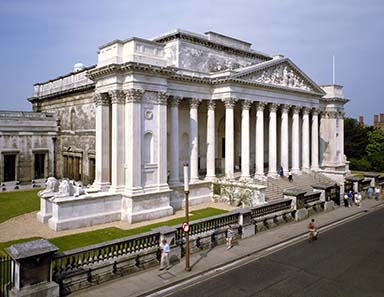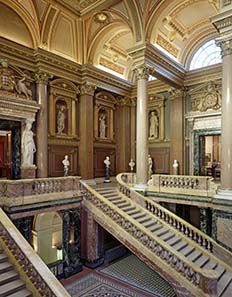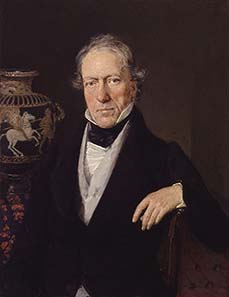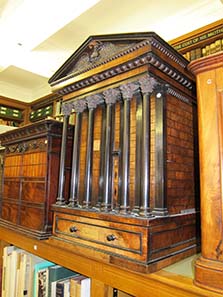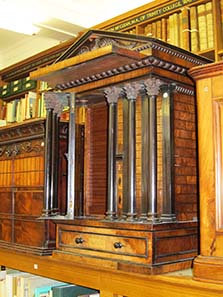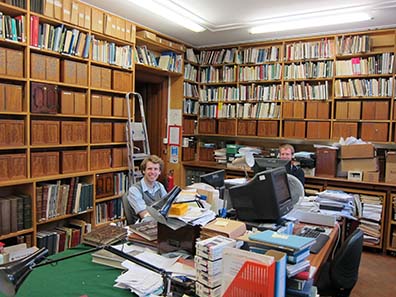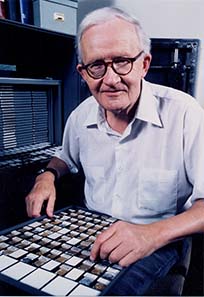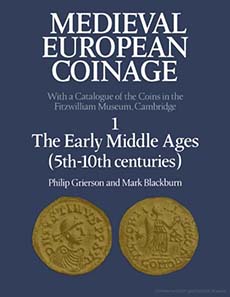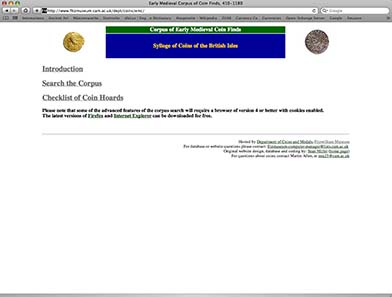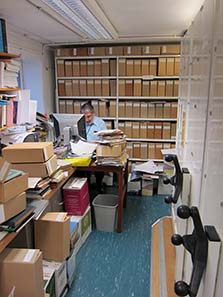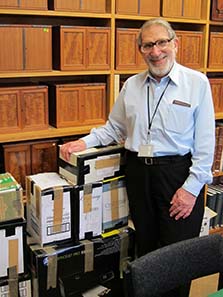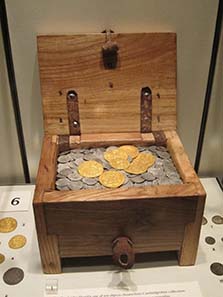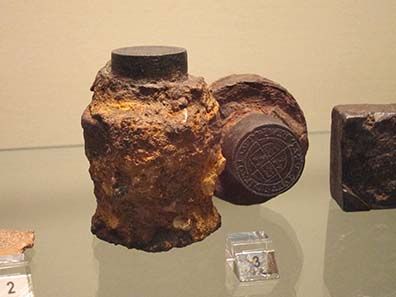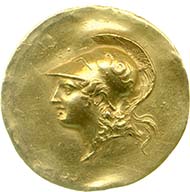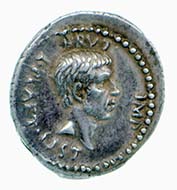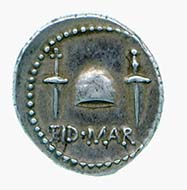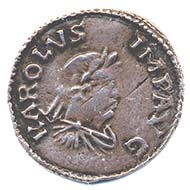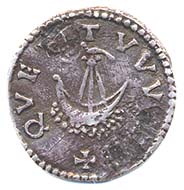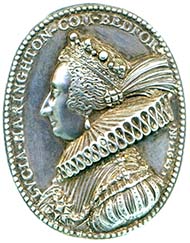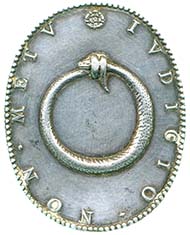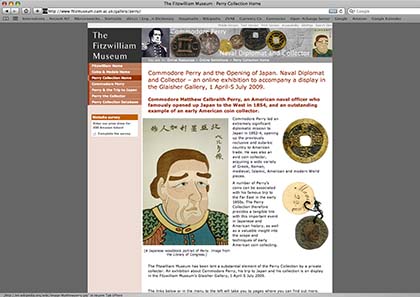April 21, 2011 – In 1816, Richard 7th Viscount Fitzwilliam of Merrion, founded the Fitzwilliam Museum, explicitly “for the purpose of promoting the increase of learning”. He donated his comprehensive collections as well as 100,000 Pounds for building a magnificent museum.
The Fitzwilliam Museum. Image: Fitzwilliam Museum.
In 1848, the Classicist building of the architect George Basevi was opened. Approximately 300,000 visitors come each year and appreciate the Fitzwilliam Museum being entrance free.
The magnificent entrance to the collection galleries. Image: Fitzwilliam Museum.
The architectural highlight is the magnificent entrance staircase. It was completed as late as 1875 and almost prevented the Leaks Collection from being incorporated into the Coin Cabinet of the Fitzwilliam Museum.
William Martin Leake, oil painting by Christian Albrecht Jensen. Source: Wikipedia.
After all, the Fitzwilliam Museum did not have any money for acquiring objects when it was built. Hence, it was mainly private collections that were given to the museum as a present. In 1860, the famous topographer and archaeologist William Martin Leake bequeathed his coin collection to the museum for the modest sum of 5,000 Pounds.
The money could have been taken from the building funds – a member of the museum advisory board, however, strongly protested against that. His opponent became the archaeologist Churchill Babington who campaigned for the purchase in a booklet. He was a visionary and envisaged that an active coin cabinet would attract further private collections. Yes, he likewise had the many collections in mind which were stored in the different colleges without being cared for. They ought to find a new home in the Fitzwilliam Museum eventually. And they did, although the very last was handed over as loan only recently.
The front study room. Image: UK.
Leake‘s collection is stored in a place separated from the other coins until the present day. The wooden caskets in which some private collections came into the museum are real beauties that contribute to the distinctive atmosphere of the museum’s study rooms.
Coin cabinet in the shape of a vase. Image: UK.
They are an attraction for themselves. The author’s highlight is a vase…
Coin cabinet in the shape of a vase. Image: UK.
…which turns out to be a coin cabinet upon closer examination. Sorting and putting away an additional coin, however, can become tricky.
Coin cabinet in the shape of a temple. Image: UK.
Almost as beautiful is this coin cabinet in the shape of a temple.
Coin cabinet in the shape of a temple. Image: UK.
The carpenter has incorporated some additional features such as a secret compartment.
Coin cabinet made of wood from the York Minster. Image: UK.
Almost a case for the protection of cultural property is this coin cabinet made of wood and metal from the medieval York Minster. Today, the box is something like a cultural property in itself.
The back study room. Image: UK.
Anyone fond of nostalgia will find in the Fitzwilliam Museum the typical feature of all coin cabinets of earlier days: a unity of collection, library and research. By the look at the cramped place, with the work stations in a localized manner, the visitor might find it hard to believe that Cambridge is the world’s leading research center for medieval numismatics.
Philip Grierson (1910-2006). Photo: Joe Mills.
The decisive figure was Philip Grierson with his passion for medieval numismatics. He was appointed honorary curator in 1949. That office he held for more than 56 years.
Coins from the collection of Philip Grierson. Image: Fitzwilliam Museum.
Philipp Grierson was a keen coin collector. During more than half a century, he managed to assemble more than 20,000 medieval coins. Together with his academic library, he bequeathed it to the Fitzwilliam Museum.
Another gift to this institution was even bigger. He initiated a project that made Cambridge famous in the entire numismatic world: the MEC.
The first volume of the MEC was published in 1986.
MEC, Medieval European Coinage: like the RIC, that catalogue was planned to make the medieval coinage accessible to a wide community of experts. Optimistically, Grierson intended to complete this project successfully in six years: he planned to publish 12 volumes in total, two each year. As a matter of fact, the MEC turned out to be a major project with numismatists from all over the world contributing. Out of the planned 17 volumes two have been published so far; ten more are in progress.
The Queen, here beside Mark Blackburn, has visited the Coin Cabinet, too. Image: Fitzwilliam.
Philipp Grierson’s perhaps biggest stroke of luck was getting Mark Blackburn to work for the Coin Cabinet of the Fitzwilliam Museum. Today, he is the Cabinet’s director and has taken charge of the MEC.
Corpus of the early medieval coin finds.
The digital account of the early medieval coins finds goes back to Blackburn’s initiative. Thanks to the general provisions on finds in Great Britain the exact find spots of scattered finds and coin hoards are known for the most part. They were recorded by Mark Blackburn in digital catalogues and are accessible to scholars all over the world.
Catalogue of Islamic coins of the Fitzwilliam Museum.
In addition, Mark Blackburn ingeniously enlarges the collection. He discovers areas which are still advantageous and significantly contribute to the expert knowledge. Under his guidance, the Islamic and Indian collections greatly expanded. He is Keeper of the Coins since 1991; and in this roughly 20 years the collection grew onto more than 70,000 objects (sic!).
Ted Buttrey in his catalogue room. Image: UK.
But not only Mark Blackburn enlarged the collection – Ted Buttrey, Keeper of the Coins from 1988 until 1991, likewise made good use of his “retirement” to turn the Fitzwilliam Museum into a center of research: he collected auction catalogues and was especially fond of those pieces others toss away. He intends to document the entire material available on the market. In 2009, Ted Buttrey was able to celebrate his 45,000th catalogue!
Ted Buttrey with catalogues ready for despatch. Image: UK.
Apart from that, the cheerful scholar has become a distribution center. Universities and museums all over the world provide him with checklists of missing auction catalogues. Ted Buttrey sends his duplicate copies. The postal charges he pays out of his own pocket.
Adi Popescu shows us coins which are incorporated into the show rooms of the Fitzwilliam Museum. Image: UK.
So much for the look behind the scenes – of course, a visitor can see coins in many other departments of the museum. Here, Adi Popescu, “Senior Assistent Keeper“, shows us the “Greek” gallery. The coin collector discovers any number of magnificent pieces!
Coin find from Cambridge, buried c. 1350. Image: UK.
It comes as no surprise that the medieval art is presented in the Rothschild Gallery in an especially enchanting manner. Pieces of utmost rarity are displayed beside precious jewellery. A unique attraction is a small hoard find buried around 1350 in Cambridge. It was once stored in a wooden box which was reconstructed for the exhibition.
Coin dies. Image: UK.
At least as interesting are these medieval coin dies.
Golden medallion dated to the 3rd cent. AD. Image: Fitzwilliam Museum.
And here are some numismatic highlights from the Cambridge coin collection. First the marvelous golden medallion dated to the 3rd cent. AD.,
Denarius of Brutus. Image: Fitzwilliam Museum.
…the historically so important denarius of Brutus,
Denarius featuring the portrait of Charlemagne. Image: Fitzwilliam Museum.
…the denarius featuring the portrait of Charlemagne,
Medal featuring the portrait of Lucy Harrington. Image: Fitzwilliam Museum.
…and the medal featuring the portrait of Lucy Harrington (1580-1627), countess of Bedford and well-known patroness of poets.
Online exhibition on Commodore Perry.
Anyone who doesn’t have an immediate chance to visit the Fitzwilliam Museum ought to have a look at the excellent internet presentation. Some of the special exhibitions are digitally documented there.
If, however, this article has made you decide to come to Cambridge right away and visit the Fitzwilliam Museum please click here for useful information about the museum.
Click here to get directly to the Coin Cabinet.
If you like to find more about the character of Philip Grierson you shouldn’t miss the enjoyable accounts of his life on the website of the Fitzwilliam Museum. Please click here.
For information about who contributes to the MEC and which volumes will be published shortly please click here.
In order to find out more about the career of Mark Blackburn click here.
You can get to the corpus of medieval coin finds if you click here.
For the checklist of coin hoards from the British Isles from 450-1180 please click here.
The catalogue of Islamic coins of the Fitzwilliam you can find here.
Please click here for a selection of virtual exhibitions.




